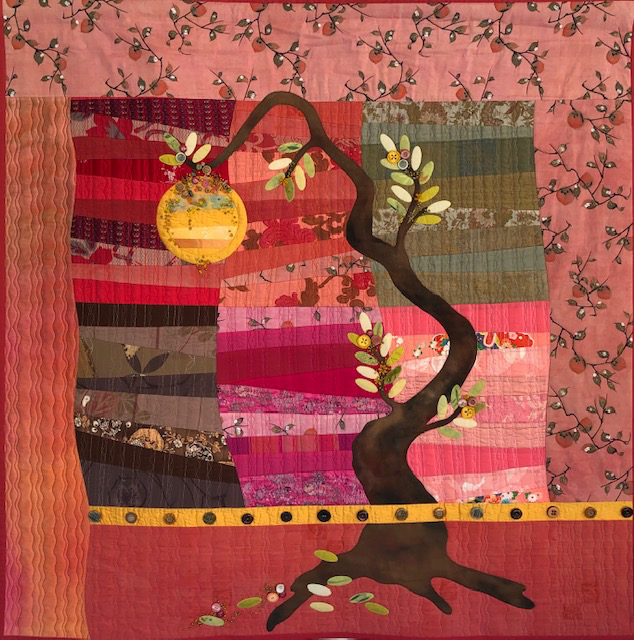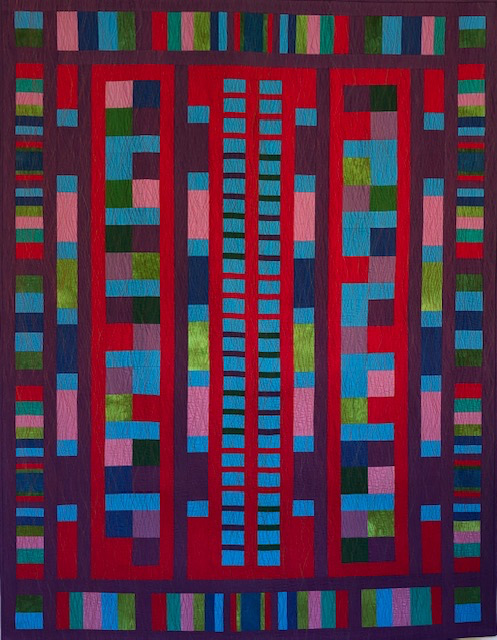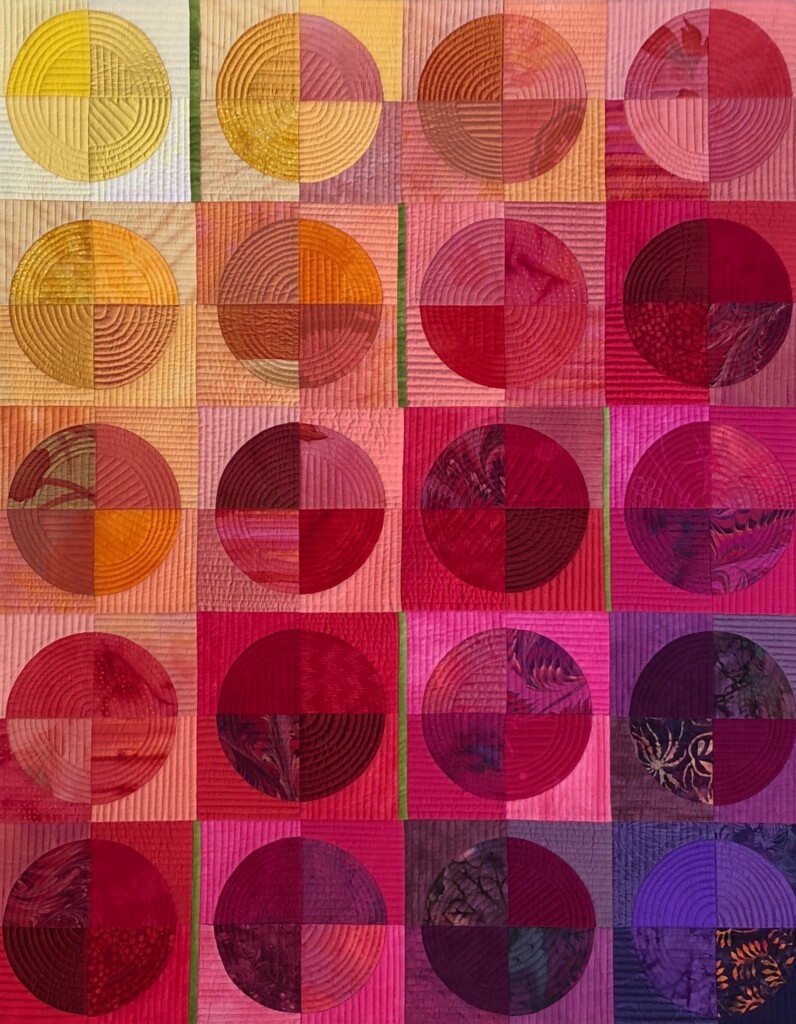For the new exhibition in the City Library which coincides with the Utah Arts Festival, a quote from Clare Hunter’s 2019 book Threads of Life is fitting for what it conveys. “Fabric and thread can convey.a prayer, trace out a map, proclaim a manifesto send out a warning, bestow a blessing, celebrate a culture and commemorate lives lived and lost. Lives expressed not just through images but through texture and color, different kinds of stitches, the various processes of piecing, patching, recycling, quilting to more clearly articulate the different layers of our humanity and manifest the fabric of our lives. Sewing is a way to mark our existence on cloth: pattterning our place in the world voicing our identity, sharing something of ourselves with others and leaving the indelible evidence of our presence in stitches held fast by our touch.”
Sheryl Gillilan, one of the three artists in Geoglyphs: Quilts by Roxanne Bartel, Sheryl Gillilan and Sondra Hodson-Rosier says in an interview with The Utah Review that the quote epitomizes the project that she and her fellow artists conceived of nearly four years ago when they visited the petroglyphs outside of Moab, Utah. The free, public exhibition opens Aug. 21 and will be open through Oct. 1 in the City Library’s Lower Urban Room. Although the library is not hosting programs from this year’s festival, the institution normally opens an exhibition to coincide with the UAF event.
“We were ruminating on the fact that many peoples since time began looked upon land as a canvas to make art,” Gillilan says, adding, “yes, but we make quilts and we discussed how we would make our own mark. This led to us thinking about how we could translate the idea of land markings into quilts. Each of us had a different style so we were able to riff off different perspectives.” The three artists have quilted together for 25 years,
The exhibition culminates in a surprisingly broad spectrum of representing the contemporary imprint on the landscapes and each artist’s vision. Gillilan enjoys aerial views of farmers’ fields with their abstract geometric shapes representing the spaces allocated for planting specific crops. She was able to leverage numerous possibilities with the old quit block pattern known as Drunkard’s Path, which is a quarter circle in a square and can easily be rearranged into different patterns. She used hand-dyed, kimono marbled cotton and silk fabrics.
Bartel expands her imagination with tree shapes while Hodson-Rosier is captivated by urban architectural styles, towers and ladders. Bartel incorporates aesthetic influences from Western and Eastern art and philosophies, producing fantasy-like images of trees that twist, curve, bend and soar toward the skies, while achieving backgrounds in straight lines and colors that pop. Bartel also dyed, stamped and painted her fabrics, while working on sketches of tree shapes that she then fused onto the background. Her choice of textiles included remnants and upcycled materials, such as silk, velvet, kimono and upholstery pieces,.
Hodson-Rosier’s work was more improvisational in approach than the other two artists. She employs asymmetrical design, improvisational piecing, and bold colors in dynamic contrasts. Based on her studies with fiber artist Nancy Crow, she incorporates techniques of free-form and commercial and hand-dyed cotton fabrics.
It is worth emphasizing that these quilts are not created as utilitarian forms but as art pieces to hang on gallery walls. Gillilan explains that she and the other artists focused on aesthetics as much as they did in achieving intricate consistency and excellence in their sewing and stitching techniques. “These are art pieces created in textile forms,” she adds. “Sewing traditionally has been viewed, with the exception of tailor’s guilds, as a woman’s job where it is utilitarian and categorized as craft.” This means that there are many quilts which often excel in one, but not both aspects. “I’ve seen quilts where the overall design concept is great but the technique could use a little help” she says, “and others where the sewing skills definitely should be admitted but the colors and shapes leave room to for improvement.” For this show, the three artists worked to ensure both aspects were worthy of a formal exhibition.
The exhibition originally was slated for last November but the ongoing pandemic precluded the installation of the show. The artists, each of whom lives in different cities or towns, communicated through email frequently, to ensure the geoglyphs theme was being rendered cohesively. The show will feature 25 quilts, ranging in smaller 23 x 23 sizes to larger formats including 50 x 50 and 64 x 50. Gillilan emphasizes that these quilts have lighter batting for the purposes of hanging art than if they would have been sewn for use on beds. Therefore, these quilts would never be washed.
“We’re pleased that quilts are being recognized as art,” she says, with the intention that viewers do not have to see quilters as grannies in a rocking chair working with a quilting hoop. The delay due to the pandemic also gave Gillilan time to complete a quilt of a field rendered in all four seasons.
For more information about all events, see the Utah Arts Festival website. Ticket information can be found here.



